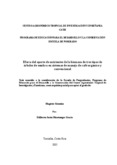| dc.contributor.advisor | Soto, G | |
| dc.contributor.author | Montenegro Gracia, E.J. | |
| dc.date.accessioned | 2014-10-17T14:42:21Z | |
| dc.date.available | 2014-10-17T14:42:21Z | |
| dc.date.issued | 2005 | es_ES |
| dc.identifier | 337708 | es_ES |
| dc.identifier.uri | https://repositorio.catie.ac.cr/handle/11554/1474 | |
| dc.description | Tesis (Mag. Sc) -- CATIE, Turrialba (Costa Rica),2005 | es_ES |
| dc.description | 67 páginas | |
| dc.description | 13 ilus. 18 tab. | |
| dc.description | 42 referencias | |
| dc.description.abstract | Se evaluó el aporte de la biomasa y la tasa de liberación de nutrientes de tres diferentes tipos de sombra (Erythrina poeppigiana, Terminalia amazonia y Abarema idiopoda), bajo sistemas de manejo convencional y orgánico de café. Así como la tasa de liberación de nutrientes de la pulpa de café fresca adicionada como fertilizante en los sistemas orgánicos. La mayor tasa de liberación la presentó el tratamiento AC de Erythrina, y la más lenta se observa en el sistema MC de Abarema. La tasa de liberación de nutrientes a partir de la pulpa de café fresca no mostró variación entre los tipos de sombra, bajo el sistema orgánico. En conclusión el sistema de manejo y el tipo de árbol de sombra determinó el aporte de nutrientes de la poda así como la tasa de liberación. La selección del tipo de sombra y el manejo de la misma son factores a considerar en el establecimiento de sistemas sostenibles de Producción de café. | es_ES |
| dc.description.abstract | The contribution of the biomass and the nutrient release rate of three shade trees (Erythrina poeppigiana, Terminalia amazonia and Abarema idiopoda), was determined under organic and conventional coffee farming systeMON, as well as the nutrient release of fresh coffee pulp added as fertilizer in the organic systeMON. AC of Erythrina showed the higher release rate, and the slowest is observed in the system MC of Abarema. Nutrient release rate from the fresh coffee pulp did not show changes among shade trees. In conclusion the farm system and the shade tree determined the nutrient release rate. The selection of the shade tree and the farming system are factors to be considering in the establishment of coffee sustainable farming systeMON. | |
| dc.language.iso | es | es_ES |
| dc.publisher | CATIE, Turrialba (Costa Rica) | es_ES |
| dc.relation.ispartof | Magister Scientiae en Agricultura Ecológica | |
| dc.subject | SHADE TREES | |
| dc.subject | SHADE PLANTS | |
| dc.subject | BIOMASS | |
| dc.subject | NUTRIENTS | |
| dc.subject | DEGRADATION | |
| dc.subject | AGROFORESTRY | |
| dc.subject | CROPPING SYSTEMS | |
| dc.subject | TRADITIONAL FARMING | |
| dc.subject | ORGANIC AGRICULTURE | |
| dc.subject | SUSTAINABILITYSOSTENIBILIDAD | |
| dc.subject | ABAREMA | |
| dc.subject | IDIOPODA | |
| dc.subject | TERMINALIA | |
| dc.subject | AMAZONIA | |
| dc.subject | ARBOLES DE SOMBRA | |
| dc.subject | CAFE ORGANICO | |
| dc.subject | COFFEA ARABICA | |
| dc.subject | ERYTHRINA POEPPIGIANA | |
| dc.subject | TERMINALIA | |
| dc.subject | PLANTAS DE SOMBRA | |
| dc.subject | BIOMASA | |
| dc.subject | NUTRIENTES | |
| dc.subject | DEGRADACION | |
| dc.subject | AGROFORESTERIA | |
| dc.subject | SISTEMAS DE CULTIVO | |
| dc.subject | AGRICULTURA TRADICIONAL | |
| dc.subject | AGRICULTURA ORGANICA | |
| dc.title | Efecto del aporte de nutrientes de la biomasa de tres tipos de árboles de sombra en sistemas de manejo de café orgánico y convencional | es_ES |
| dc.title.alternative | Effect of nutrients supply of biomass from three types of shade trees in management systems of organic and conventional coffee | es_ES |
| dc.type | Tesis de maestría | es_ES |
| dc.identifier.publication | Turrialba (Costa Rica) | es_ES |


